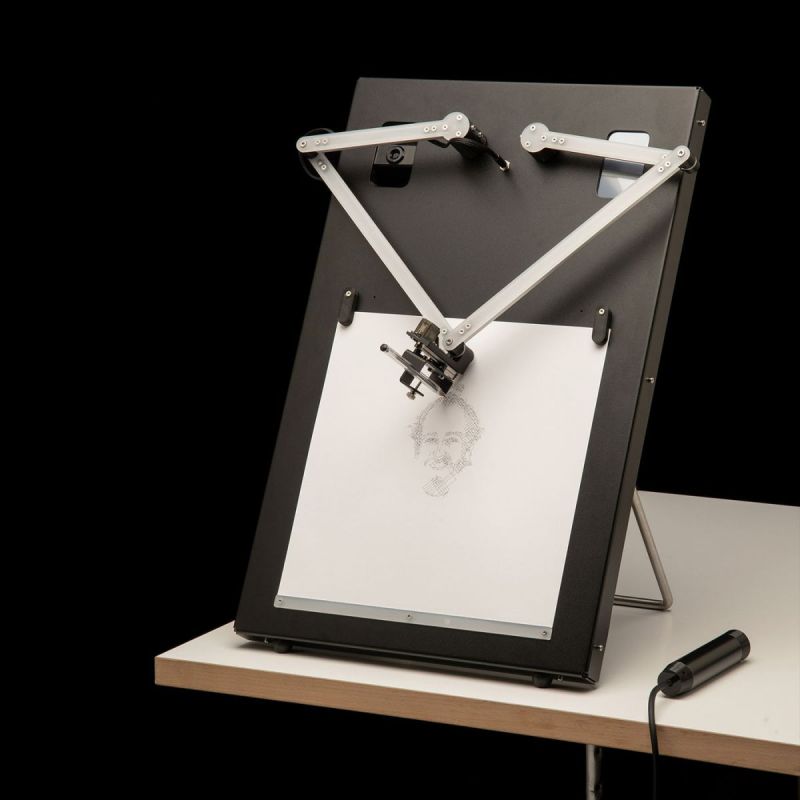Although the market for hand-drawn portraits largely collapsed following the invention of photography, there’s something magical about watching an artist create a lifelike image using nothing but a pencil, some paper, and their fine motor skills. Watching a machine do the same is a similarly captivating experience, though often the end result is not so great. Trying to fix this deficiency, [Joris Wegner] and [Felix Fisgus] created the Pankraz Piktograph which seems to do a pretty good job at capturing faces. They were inspired by classic picture-drawing automatons, and made a 21st-century version to be used in museums or at events like trade shows.
The operation of the Piktograph is very simple: you stand in front of the machine, look into the camera and take a selfie. If you like what you see, the robot will then begin to draw your portrait on a piece of paper. It does this using two human-like arms which are made from aluminium and driven by two stepper motors. An ordinary ballpoint pen is held in a spring-loaded carrier, which provides just enough pen-to-paper pressure to reliably draw lines without lifting off or scratching the paper. We can’t help but be impressed with the overall look of the machine: with a sleek, powder-coated aluminium case and a stainless steel stand it’s a work of art by itself.
Inside, the Piktograph is powered by a Raspberry Pi 3, which runs a rather sophisticated algorithm to generate a vector image which doesn’t take too long to draw, but still results in a recognizable image of the subject. The makers’ thesis goes into quite some detail to explain the process, which uses Canny edge detection to create an outline drawing, then fills in the empty bits to create bright and dark areas. A certain amount of noise and wigglyness is added to the lines to give it a more “handmade” feel, and the resulting drawing is divided into continuous lines for efficient drawing by the plotter.
We’ve seen several types of specialized art robots before, capable of drawing portraits with a pen, painting them, or even using an Etch-a-Sketch, but [Joris] and [Felix]’s creation seems to win on speed, workmanship, and the quality of the end result. Video embedded after the break.
















Darn, I was hoping to finally see an algorithm that actually *drew* a picture. But this is yet another plotter that converts a webcam picture to an edge-enhanced low-resolution 4-level grayscale bitmap, and varies the hatch pattern to achieve the desired darkness at each chunky pixel.
Sure, it’s “art”, and I’m sure worthy of a Master’s degree in Digital Media, but I’m not qualified to judge such a thing.
How exactly is that any different from what a human brain does when a human draws a picture? People draw edges first then go back and shade in between the lines. Our webcams are our eyes, which might as well be grayscale if we’re only drawing with a black pen or pencil, and our hands vary the pattern of whatever we’re shading almost on their own. It’s the breaking down of a biological process into a mechanical one and arguably achieving better results.
I really like it. I should build a plotter of my own. I’ve been meaning to for a while.
He was probably talking about the filling/shading process and also the fact that humans have a tendency to stylize their portraits.
The problem with theses kind of plotters is that they all have a similar result. It’s a nice result but also very “robotic”.
One problem if you want to do shading like a human, at least with a gray pencil is that you need more freedom over the orientation of the pen, but also the pressure. It seems really difficult to do a plotter with these two “degrees of freedom “. And I don’t even talk about the software part…
I’m talking about the reduction of the drawing to just the essential lines — so-called minimalist sketching. Examples abound: https://www.google.com/search?q=minimalist+sketch&source=lnms&tbm=isch&sa=X
you could run the picture through an emboss filter etc, that should give a result more towards your desired minimal sketch
>People draw edges first then go back and shade in between the lines.
Not necessarily. That’s just about what style you’ve learned. You _usually_ start from a geometric sketch which you refine into an outline to help you get the shape correct, then add colors and shades, which makes it easy to approach and teach, not necessarily the way we would approach the problem “naturally”. Artists often do it the other way around, starting from gradients and refining them into outlines and shapes by adding contrast.